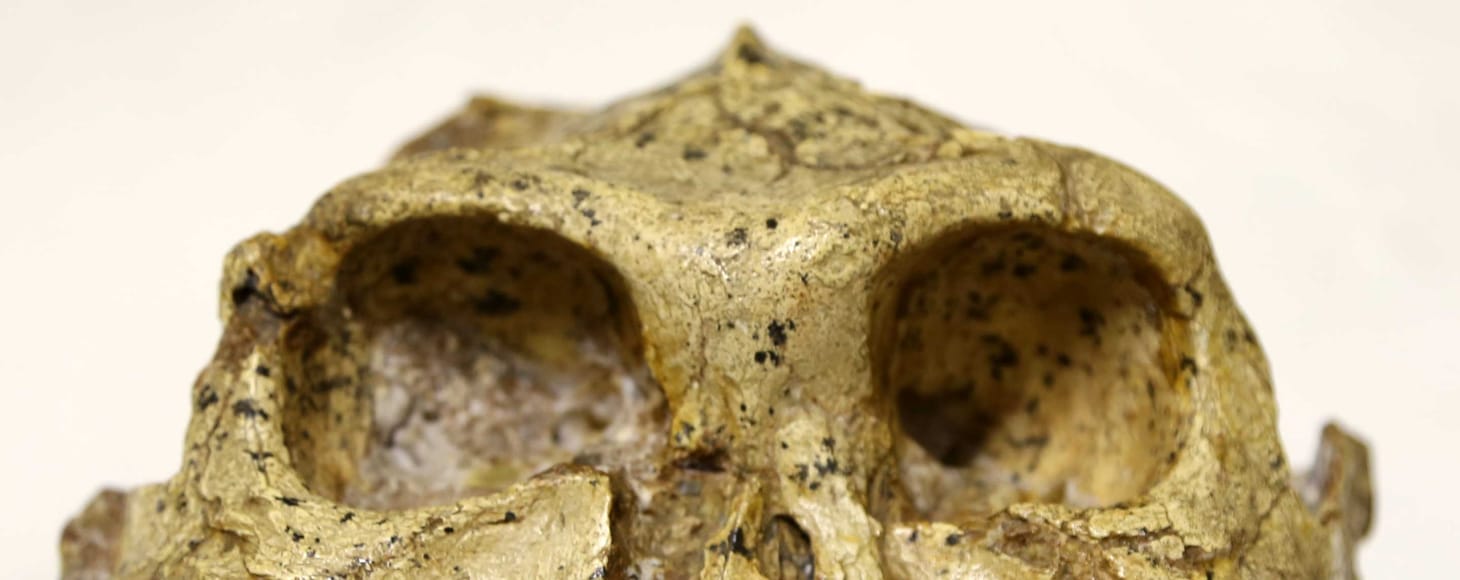All the hominins made tools
A study of associations between stone tool evidence and fossil hominin remains shows that a wide range of species made stone artifacts.
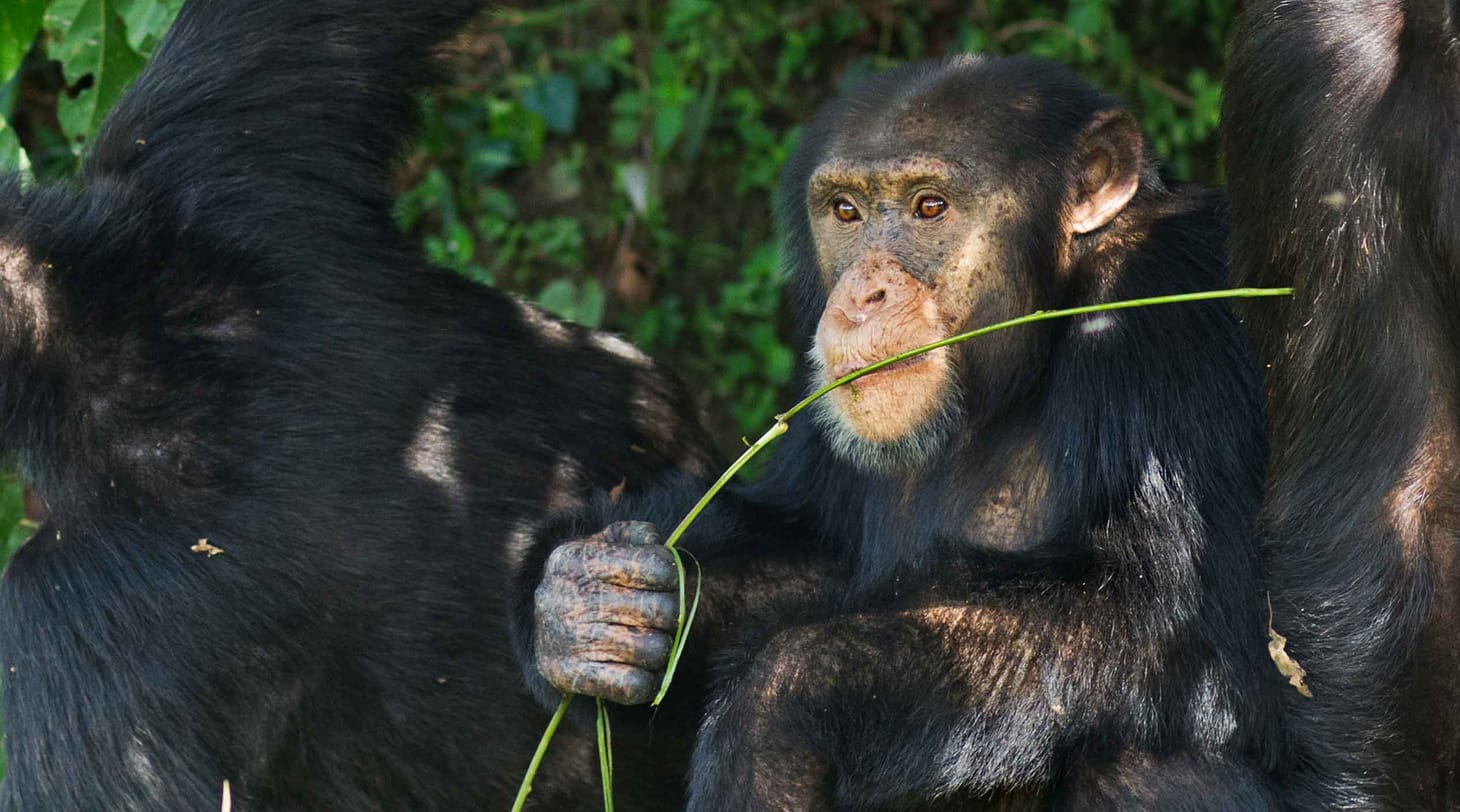
The two inventors of the idea of natural selection had somewhat different viewpoints about how technology mattered to human origins. In an 1864 lecture, Alfred Russel Wallace observed that tools, weapons, and clothing all tend to remove humans from the direct action of natural selection on the form of the body. Wallace suggested that the physical features of the human body had become “fixed and permanent”. Instead, he offered, Man had been “kept in harmony with the slowly changing universe around him, by an advance in mind, rather than by a change in body.”
Charles Darwin also saw tools and weapons as highly important to human evolution. But where Wallace had suggested a major shift in natural selection away from bodies toward minds, Darwin emphasized the continuities that link humans and other primates. He discussed evidence of the use of stones by chimpanzees for cracking nuts, and mentioned that some American monkeys were easily trained to do the same. Darwin saw it as essential that people differ from other animals in degree, not in kind, and he considered this equally true for mental as for physical characteristics. For Darwin, this continuity of structure and behavior was a powerful argument that natural selection had crafted humans just as it had crafted other species. Where others imagined a gulf, Darwin invariably saw stepping stones.
This difference between Wallace and Darwin comes to mind when I look at the way that paleoanthropologists discuss evidence of tool use. Many researchers have considered stone and bone tools to be uniquely connected with the origin of our own genus, Homo. Like Wallace, they imagine a transition in our evolutionary trajectory: Once our ancestors began to rely more and more on technology, natural selection on the form of the body became less and less relevant. The evolution of toolmakers would be driven by natural selection on the mind.
But humans are far from unique in our use of technology. Our closest living relatives, chimpanzees and bonobos, are technical species that use a wide array of tools, mostly made from organic and perishable materials. Both bonobos and chimpanzees use tools as part of their social interactions with other individuals, and both species use tools sometimes to make themselves feel more comfortable. Chimpanzees additionally make and use a wide array of tools to help them get foods that are hard to process without tools, for example by cracking nuts, “fishing” for termites, or extracting honey from underground bee nests. Most chimpanzees do not use stone, but western chimpanzees use stones for nutcracking and a fascinating behavior known as “accumulative stone throwing”. Bonobos and chimpanzees have hands and wrists that are very different from humans, specialized for knuckle-walking on the ground and suspending below branches while climbing. These marked differences in anatomy do not impede chimpanzees or bonobos from manipulating objects, shaping them for a purpose, and using the resulting tools to accomplish their aims.
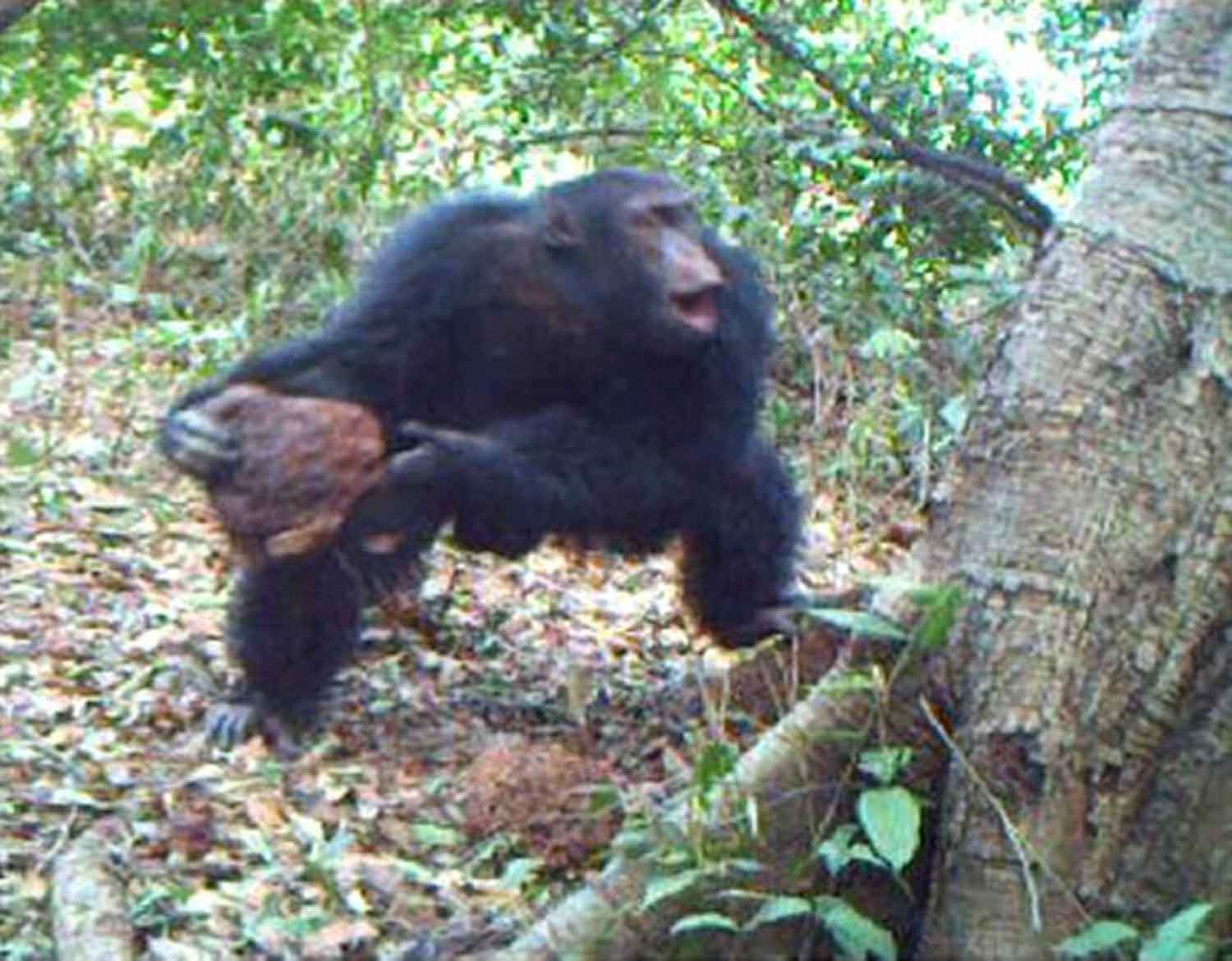
Bonobos and chimpanzees help show how much variation in social learning of toolmaking can evolve between closely related species. Nearly all the differences between them are manifested in perishable materials, tools that would leave no trace after millions of years. Every indication from the anatomy of early hominins and their ecology points toward Darwin's insight that the technical behavior of nonhuman primates is continuous with behavior once manifested by human ancestors and early humans.
Many species made early stone and bone tools
The earliest-known stone tools are from Lomekwi 3, Kenya, made around 3.3 million years ago and first described by Sonia Harmand and the West Turkana Archaeological Project in 2015. The toolmakers, whoever they were, lived a half million years before the earliest fossils that have been attributed to the genus Homo. The only fossil hominin identified from the Lomekwi area around this time is Kenyanthropus platyops.
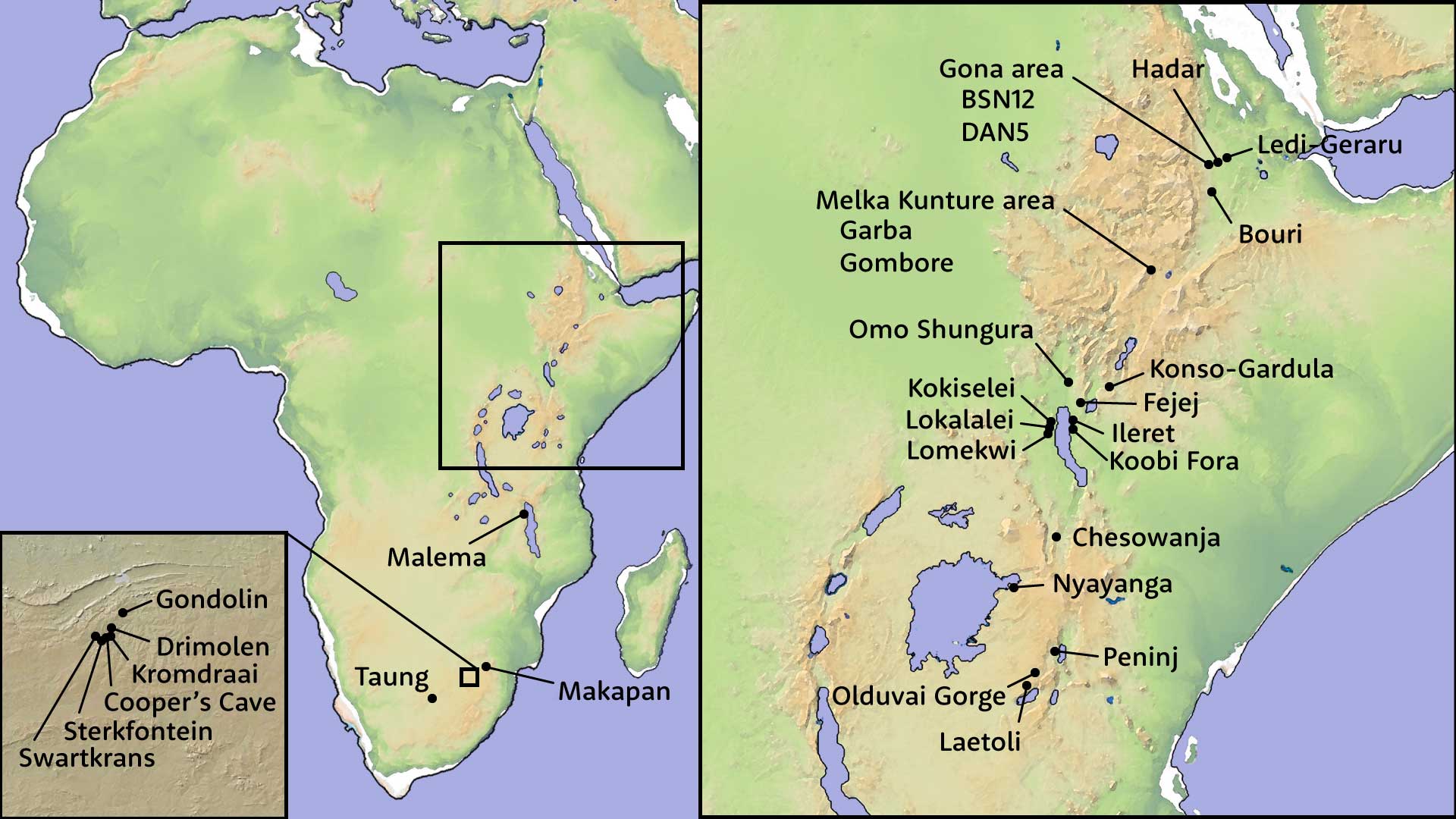
Fossils and artifacts are associated when both are found within the same sedimentary context, buried at around the same time in the same place. Few early archaeological sites have any hominin fossils. When a hominin fossil happens to be found at such a site, it is often only a single tooth or small fragment of bone. For example, a recent paper by Dylan Flicker and Alister Key lists ten archaeological sites with Oldowan artifacts that have been dated to the period between 2.6 million and 2.0 million years ago. Out of the ten sites, only five have any trace of hominin fossil remains, only one of the five has hominin fossils that are identifiable to the species level—in this case, Paranthropus robustus in Sterkfontein Member 5 East.
Earlier this year, Thomas Plummer and coworkers described the earliest association between stone artifacts and hominin fossils, from Nyayanga, Kenya. This site has now produced the oldest-known Oldowan archaeological material, between 3.03 million and 2.58 million years old. The two hominin fossils are a single isolated molar and a second tooth fragment. Both are similar to teeth of Paranthropus, although the teeth provide too little information to attribute them to a species.
In a recent article in L'Anthropologie, Sandrine Prat reviewed the record of association between stone tool evidence and fossil hominin remains, from the period between 3 million and 1.2 million years ago. The review included twenty-nine situations with artifacts and fossil hominin remains, all from Ethiopia, Kenya, or Tanzania. She also discusses sites in South Africa, while recognizing that the geological situations represented by these cave sites are not quite equivalent to the open air sedimentary deposits from the East African Rift System.
I plotted these sites all together here, adding a handful of data points from other situations that also fall within the same time range, such as Dmanisi, Republic of Georgia. I also added Lomekwi 3, despite the lack of direct association with hominin fossils, to show where later sites fit relative to these earliest known artifacts.
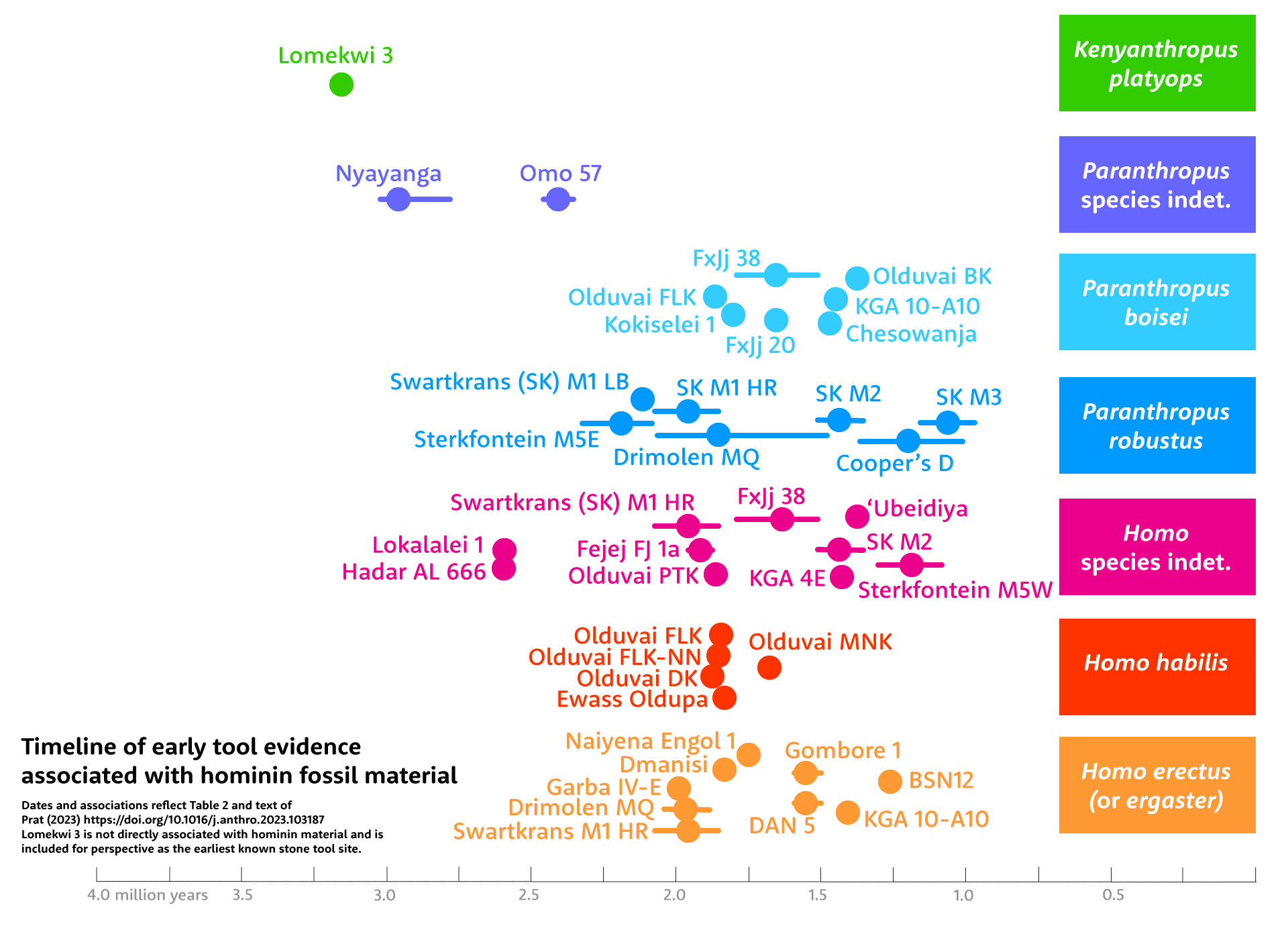
The pattern is striking. Paranthropus and Homo species are both found in association with stone and bone artifacts throughout the period of their coexistence. The data provide no reason to suggest that either of these branches of hominins is more or less a toolmaker than the other.
Prat also discussed anatomical evidence from these species, particularly the form of the hand and wrist. All known hand and wrist fossils from Australopithecus and Paranthropus are consistent with the kinds of grips used in making and using stone tools. To be sure, there have been many scientific debates about the functional anatomy of hand and wrist fossils from these early hominins. But those debates have been about whether some features of the Australopithecus and Paranthropus hands may reflect a greater reliance on climbing than in Homo. All features of these hominin hands are consistent with fine motor control and manipulation of objects in ways consistent with tool use. That means there's no anatomical basis to say that Paranthropus or Australopithecus used tools less than Homo. That should be no surprise, considering the extent of tool use by chimpanzees and bonobos without the same ability to produce many of the grips used by humans.
Paranthropus: the neglected toolmaker
Paranthropus robustus is the most common hominin represented in South African sites between 2.3 million and 1.0 million years ago. Nearly every context with fossils of P. robustus also has stone artifacts and bone tools. In the East African Rift System, Paranthropus boisei is the most common hominin species across the same range of time. Many sites with P. boisei also have stone artifacts, although the sedimentary exposures of the rift quite commonly have fossils that are found in isolation without other fossils or artifacts nearby. Only in the northeasternmost section of the Ethiopian Rift was P. boisei absent.
With this pattern of association of stone and bone artifacts with Paranthropus, it may seem challenging to explain why archaeologists long ignored this branch of hominins as potential tool using species. This bias can be tracked back to the 1950s, as John Robinson, C. K. Brain, and Revil Mason uncovered evidence of stone tools in the deposits of Sterkfontein.
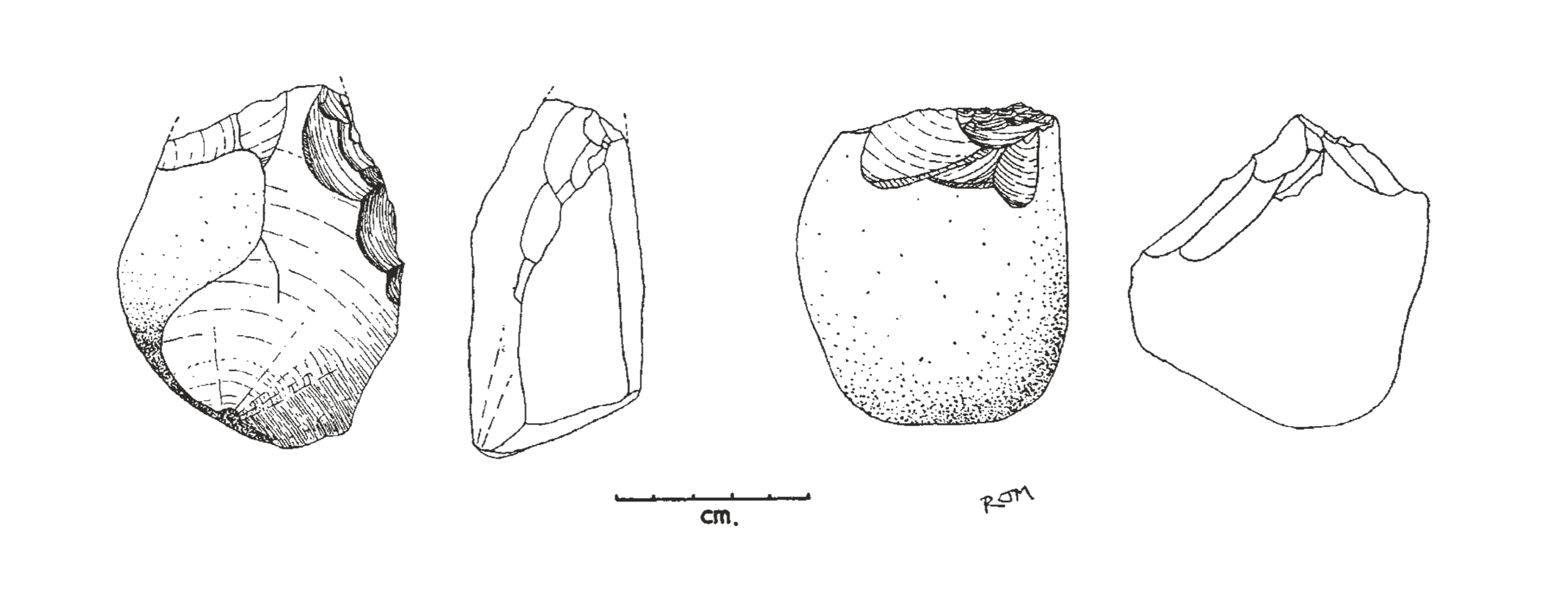
Working under Robinson's direction, Brain and Mason opened an area of excavation at Sterkfontein that became known as the Extension Site. In the westernmost part of this area, the breccia contained many stone tools. In 1959, Robinson identified a bone tool from the site, marked by striations and polish on its tip. For twenty years, first Robert Broom and then John Robinson had found fossils of Australopithecus africanus at Sterkfontein. Was this species the toolmaker?
In early August of 1959, Mary Leakey excavated the first fossil skull of the species we know today as Paranthropus boisei, from level 22 of the FLK site at Olduvai Gorge. Louis and Mary Leakey had interpreted this level as a “living floor”, with abundant stone artifacts of the tradition they had named the Oldowan Industrial Complex. In his description of the skull, which he named Zinjanthropus, Louis emphasized its near-pristine preservation as a reason why this individual was different from the broken and fragmented animal bones at the site. Zinjanthropus, he argued, must be the maker of the tools.
Many anthropologists were happy to accept these hominins as makers of stone tools. For example, Sherwood Washburn discussed the Zinjanthropus discovery as confirming the discoveries by Robinson and Brain that seemed to associate Australopithecus with artifacts. He ridiculed the assertion by some other researchers that “no creature with so small a brain could have made tools”. Nevertheless, he wrote, the problem could only be solved by excavation.
“An association in one site cannot settle the matter, and the situation is further complicated because several kinds of Australopithecus and Homo may have made tools. It is perfectly possible that different species of australopithecines and early Homo lived at the same time and all made tools.”—Sherwood Washburn
One of the scientists with doubts was Robinson himself. His work made clear that the Australopithecus fossils from Sterkfontein were older than the Swartkrans breccia, which had fossils of Paranthropus robustus as well as a more humanlike form that Robinson and Robert Broom had called Telanthropus capensis. Robinson viewed Telanthropus as “an australopithecine that had attained euhominid status”—in other words, something that today we would recognize as early Homo. A few years later Robinson would accept Telanthropus as identical to Homo erectus, although today researchers see this as a heterogeneous group of fossils which may include some early Homo individuals but also some that belong to P. robustus or Australopithecus sediba. Brain had identified some quartzite artifacts in the Swartkrans breccia. As they continued to work the Sterkfontein deposits, it became clear that the artifact-bearing breccia was somewhere in the middle: later than most of the Australopithecus fossils from the site but earlier than Swartkrans. Still, even though the artifacts seemed to be later than most of the Australopithecus deposit, Robinson identified some Australopithecus-like fragments in the area where stone tools were found, and no other hominin remains.
Robinson admitted that it seemed logical to conclude that Australopithecus had made the tools. In fact, Robinson, Mason, and many others at the time accepted Raymond Dart's idea that the pattern of broken animal bones from the Makapan Limeworks site might represent an early use of bones as tools by Australopithecus. But Robinson considered the stone tools from Sterkfontein too advanced for the earlier species, and he noted that most of the Australopithecus fossils, from Sterkfontein, Taung, and Makapan, had come from contexts where no stone tools had yet been found. He thought that Telanthropus must surely have made the stone tools instead. The very absence of evidence became a centerpiece of his argument:
“Perhaps the very fact that Australopithecus is common at Sterkfontein is an argument against it being a tool-maker, since in all other very early Stone Age sites remains of the tool manufacturer are extremely rare.”—John Robinson
Today researchers have established that Robinson's West Pit included breccia that belongs to Member 5 West deposits, which include Oldowan artifacts and some bifaces, and likely postdates 2 million years ago. The earlier Oldowan Infill of Member 5 East is the earliest-known Oldowan assemblage from South Africa with a cosmogenic date assessment of 2.18 ± 0.21 Myr and currently includes only Paranthropus fossils.
The Olduvai Gorge picture changed markedly in 1960 with the discovery of the OH 7 mandible, partial cranium, and hand at the FLK-NN site. The OH 7 jaw was much more like Australopithecus than the Zinjanthropus skull had been, but its parietal bones suggested a larger brain size—ultimately Phillip Tobias would estimate it as 750 ml. As Mary and Louis Leakey continued to work, they found remains of more individuals with a similar dental pattern, different from Zinjanthropus. None of the other cranial remains reflected a brain as large as OH 7, but fossils like OH 16 and OH 13 were a bit larger in brain size than Australopithecus was. By 1964, Louis Leakey, Phillip Tobias, and John Napier were ready to recognize these as a transitional species between Australopithecus and Homo erectus: they named it Homo habilis.
Everything that Louis Leakey had said about Zinjanthropus being the Oldowan toolmaker, he now took back.
“While it is possible that Zinjanthropus and Homo habilis both made stone tools, it is probable that the latter was the more advanced tool maker and that the Zinjanthropus skull represents an intruder (or a victim) on a Homo habilis living site.”—Louis Leakey, Phillip Tobias, and John Napier
Homo habilis was the favored hominin. Zinjanthropus, once vaunted as the toolmaker, was now roadkill. For many scientists, Leakey's backtracking was all they needed as proof that stone tools were the exclusive province of Homo.
It would take two decades for scientists to recognize the toolmaking potential of Paranthropus. The most important researcher behind this change was C. K. Brain. After more than twenty years working to understand the Swartkrans site, Brain had learned much about the associations of hominin fossils and their entry into the site. He found more bone tools, similar to the one noted by Robinson at Sterkfontein, and together with Pat Shipman quantified the wear that marked the tips of the tools as the possible result of digging in stony soil for underground bulbs. Later research by Lucinda Backwell and Francesco d'Errico further suggested that some of the bone artifacts had been used to puncture hard termite nests. Brain showed that P. robustus was the predominant hominin element in the Swartkrans assemblage, with Homo very rare within the deposits, yet artifacts were present throughout. The hand fossils also told a story. Analyzed by Randall Susman and reviewed by Brain, it was clear that the Paranthropus hand anatomy was fully capable of making and using tools.
“The notion that toolmaking provided the adaptive wedge that separated the robust australopithecines from the gracile australopithecines and early Homo may be tenable no longer.”—C. K. Brain and coworkers
Which hominin species lacked stone or bone artifacts?
While today's data associating some archaeological materials with fossil hominin remains are much better than the past, they remain incomplete. Before 3 million years ago, the only known site with stone artifacts is Lomekwi 3. As discussed above, the hominin fossils from the Turkana Basin near that time have been classified as Kenyanthropus platyops. The more widespread Australopithecus afarensis, which lived much further north in the Afar triangle of Ethiopia, and further south at Kantis, Kenya, and Laetoli, Tanzania, may have been present in the Turkana Basin also. I don't think we can be sure which early species made these particular tools, nor would I bet that someone won't find even earlier artifacts.
At the very least, though, I think we must acknowledge that the use of stone artifacts was rare before 3 million years ago. Most hominins from this time, including species such as Australopithecus anamensis and Australopithecus deyiremeda, may not have used stone. That wouldn't surprise me at all: both bonobos and eastern and central chimpanzees show how extensive toolmaking can be without using stone as a raw material. But I don't think the record is strong enough to rule out stone tool use of the kind practiced by western chimpanzees, including the use of hammerstones for nutcracking and minimal transport of stone. It would be very challenging to test for this kind of behavior with the kinds of archaeological surveys that have been practical in fossil exposures from the Pliocene.
In addition to direct evidence from artifacts, there may be indirect evidence of stone tool use, such as cutmarks and puncture marks on the bones of prey animals. In 2010, Shannon McPherron and coworkers reported that 3.4-million-year-old animal bones from Dikika, Ethiopia, show cutmarks from stone tools, although they did not find the artifacts themselves. Some other researchers disputed this evidence, suggesting that crocodiles or other carnivores might have generated these marks.
A higher degree of acceptance has been given to claims of cutmarks and puncture marks on antelope and horse bones from 2.5 million years ago, at Bouri, Ethiopia. Some of these discoveries were near the BOU-VP-12 locality with fossil material of Australopithecus garhi. Other sites from this region, including Gona, Hadar, and Ledi-Geraru, do preserve stone artifacts from the same time or earlier, but without any associated hominin remains. Later, around 3.3 million years ago, stone tools from Hadar have been associated with a maxilla attributed to early Homo, but the first possible mandible of Homo from Ledi-Geraru is not from a locality with artifacts.
Australopithecus africanus remains a challenging case. No stone tools have been found in contexts where Au. africanus fossils clearly occur, at Sterkfontein, Makapan Limeworks, or Taung. Recent work has shown that the Sterkfontein Member 4 fossils of Au. africanus may be older than 3.4 million years—therefore, older than any known artifacts anywhere. The Makapan and Taung sites themselves may be older than 2.8 million, and so it is possible that Au. africanus simply existed before stone tools were used in South Africa. Yet there remains some uncertainty. For one thing, some authors dispute the idea that Sterkfontein Member 4 is as early as 3.4 million years, preferring a date between 2.6 million and 2.1 million years ago. Another element of uncertainty comes from the StW 53 cranium, which I and many other scientists attribute to Au. africanus, and which has marks on its maxilla that some authors have argued are cutmarks from a stone artifact. Just as for Paranthropus, the anatomical evidence from the hand bones of Au. africanus suggests that this species had the fine precision grip and relied on hand postures that today's humans use for making and using tools.
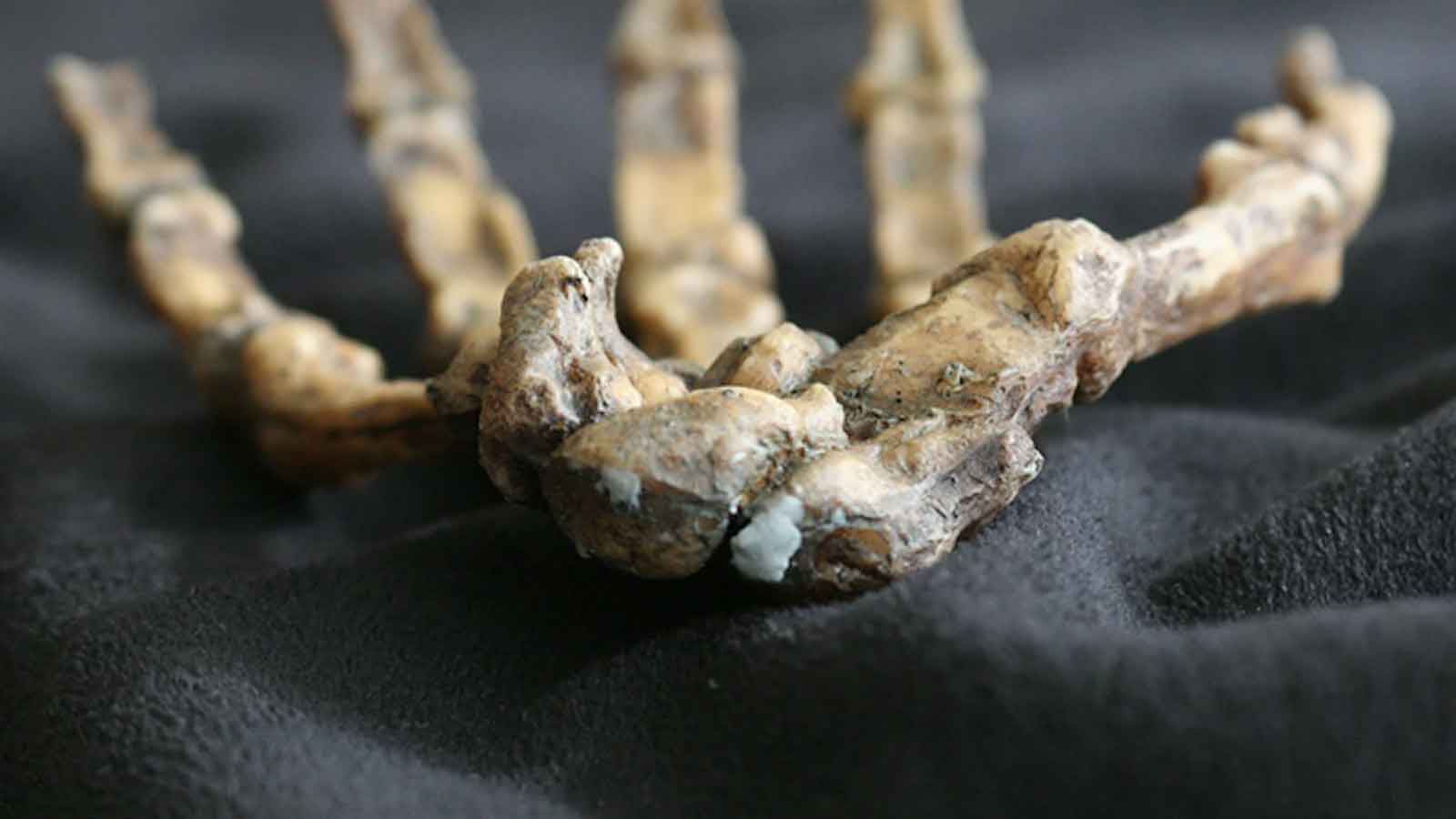
The notable late Australopithecus site is Malapa, with Australopithecus sediba at 1.977 million years ago. No artifacts have yet been reported from this locality. Still, recent work from Clément Zanolli and coworkers has shown that many dental and mandibular fossils from Swartkrans, Drimolen, and Sterkfontein Member 5 that were previously attributed to Homo may instead belong to Paranthropus or Australopithecus. It seems probable that many of these may be unrecognized Au. sediba individuals. Any of those would be associated with Oldowan artifacts and bone tools from these sites.
The well-known species of Homo that doesn't show up in the dataset on associations of artifacts and fossils is Homo rudolfensis. This is another case where only a handful of fossils are clearly associated with this species. It may be surprising, but I would argue that only four fossils might be strongly linked to H. rudolfensis: the KNM-ER 1470 cranium, KNM-ER 62000 subadult face, and two mandibular fossils—KNM-ER 60000 and KNM-ER 62003. None are from localities with archaeological material. There are other fossils that might conceivably belong to H. rudolfensis, but many of the ones that past anthropologists connected with this species, like the KNM-ER 1802 mandible or the UR 501 mandible from Uraha, Malawi, may be Australopithecus instead.
Toolmaking ecology across species
It's clear that associations of fossils and artifacts can go only so far. Robinson preferred the hypothesis that the most advanced hominin on the scene must have made any artifacts. Many researchers during the last 60 years have followed this point of view. But today's data allow us to test whether any fossil species is consistently associated with artifacts. After around 2.8 million years ago every fossil species is found with artifacts, with the few exceptions being those species that have been identified from only a single locality or—in the case of H. rudolfensis—a handful of localities. The two branches that are found most regularly with artifactual evidence, Paranthropus and Homo, are both represented at archaeological localities in equal measure; only Paranthropus is present at the earliest two Oldowan localities.
It is hard for me to improve on C. K. Brain's conclusions about tool use. By the Early Pleistocene, all hominins had the anatomical capability of making and using stone tools, and most of them did so. As in living bonobos and chimpanzees, tool use may have differed markedly between species and populations, depending upon their particular ecological situations. It was the uses of the tools that differentiated the hominins, not the capacity to use tools.
Yet maybe even this underestimates the commonalities across species. Stable isotopes and dental microwear suggest that P. robustus and early Homo in southern Africa were eating similar foods, despite what seem to be some important differences in dental morphology. If their ecologies were much the same, and their hand anatomies were much the same, it is hard to justify any assumption that they would have been different in their use of tools.
Going further, wherever both species existed they both would have encountered each other's trash. Each individual scattering stone across a landscape changed the potentialities for every other hominin. Each species existed within the ecology of the other. When one was rapping cobble on core, others heard them hundreds of meters away. They learned from each other. Their use of resources must often have converged.
Darwin wrote eloquently about the way that small steps in tool use would change the potentialities for “primeval” humans.
“The Duke of Argyll remarks, that the fashioning of an implement for a special purpose is absolutely peculiar to man; and he considers that this forms an immeasurable gulf between him and the brutes. It is no doubt a very important distinction, but there appears to me much truth in Sir J. Lubbock's suggestion, that when primeval man first used flint-stones for any purpose, he would have accidentally splintered them, and would then have used the sharp fragments. From this step it would be a small one to intentionally break the flints, and not a very wide step to rudely fashion them.”—Charles Darwin
Tool use does not make humans unique; it links us to our ancestors and relatives. Those links that remain are phylogenetic, but they were once living cultural links. It is true that recent humans have become reliant upon our tools in ways that early hominins would not have recognized. Before this time we lived in a world of transitions into and out of technical traditions. The steps across species in tool use were once small ones, interconnected actions that spanned differences in body size and form.
Notes: The current evidence of hand anatomy in various hominins is ably reviewed in several papers by Tracy Kivell, Matt Skinner, and many of their collaborators. The work by Clément Zanolli and coworkers highlighting internal dental evidence for affinities of South African dental material is worth reading for its broader implications: we have little reliable information about the species identity of many isolated finds. I did not include in the references below all the works that underlie the dataset described by Sandrine Prat, or every paper related to the dating of sites discussed in the post.
I've only included a few words here about the cultural behavior of chimpanzees and bonobos. This is a rich area with deep importance for understanding early hominins, and hopefully I will be able to expand on this in an additional post.
There may be readers who suspect I am being unfair to Wallace in this comparison of views on technology. The differences between Wallace and Darwin on the extent that natural selection could explain human cultural abilities have been the subject of many historians of science, and two paragraphs inevitably oversimplify these differences. I think it's fair to say that Darwin and Wallace were concerned with different aspects of the human origins problem.
References
Brain, C. K., Churcher, C. S., Clark, J. D., Grine, F. F., Shipman, P., Susman, R. L., Turner, A. and Watson V. (1988). New evidence of early hominids, their culture and environment from the Swartkrans cave, South Africa. South African Journal of Science, 84(10), 828. https://doi.org/10.10520/AJA00382353_6877
Darwin, C. (1871). The Descent of Man, and Selection in Relation to Sex. John Murray.
Flicker, D., & Key, A. (2023). Statistical assessment of the temporal and cultural relationship between the Lomekwian and Oldowan. Journal of Archaeological Science: Reports, 48, 103834. https://doi.org/10.1016/j.jasrep.2023.103834
Harmand, S., Lewis, J. E., Feibel, C. S., Lepre, C. J., Prat, S., Lenoble, A., Boës, X., Quinn, R. L., Brenet, M., Arroyo, A., Taylor, N., Clément, S., Daver, G., Brugal, J.-P., Leakey, L., Mortlock, R. A., Wright, J. D., Lokorodi, S., Kirwa, C., … Roche, H. (2015). 3.3-million-year-old stone tools from Lomekwi 3, West Turkana, Kenya. Nature, 521(7552), Article 7552. https://doi.org/10.1038/nature14464
Kivell, T. L., Baraki, N., Lockwood, V., Williams-Hatala, E. M., & Wood, B. A. (2023). Form, function and evolution of the human hand. American Journal of Biological Anthropology, 181(S76), 6–57. https://doi.org/10.1002/ajpa.24667
Kühl, H. S., Kalan, A. K., Arandjelovic, M., Aubert, F., D’Auvergne, L., Goedmakers, A., Jones, S., Kehoe, L., Regnaut, S., Tickle, A., Ton, E., van Schijndel, J., Abwe, E. E., Angedakin, S., Agbor, A., Ayimisin, E. A., Bailey, E., Bessone, M., Bonnet, M., … Boesch, C. (2016). Chimpanzee accumulative stone throwing. Scientific Reports, 6(1), Article 1. https://doi.org/10.1038/srep22219
Leakey, L. S. B. (1959). A New Fossil Skull From Olduvai. Nature, 184(4685), Article 4685. https://doi.org/10.1038/184491a0
Leakey, L. S. B., Tobias, P. V., & Napier, J. R. (1964). A New Species of The Genus Homo From Olduvai Gorge. Nature, 202(4927), Article 4927. https://doi.org/10.1038/202007a0
McPherron, S. P., Alemseged, Z., Marean, C. W., Wynn, J. G., Reed, D., Geraads, D., Bobe, R., & Béarat, H. A. (2010). Evidence for stone-tool-assisted consumption of animal tissues before 3.39 million years ago at Dikika, Ethiopia. Nature, 466(7308), Article 7308. https://doi.org/10.1038/nature09248
Oakley, K. (1957). Tools Makyth Man. Antiquity, 31(124), 199–209. https://doi.org/10.1017/S0003598X00028453
Plummer, T. W., Oliver, J. S., Finestone, E. M., Ditchfield, P. W., Bishop, L. C., Blumenthal, S. A., Lemorini, C., Caricola, I., Bailey, S. E., Herries, A. I. R., Parkinson, J. A., Whitfield, E., Hertel, F., Kinyanjui, R. N., Vincent, T. H., Li, Y., Louys, J., Frost, S. R., Braun, D. R., … Potts, R. (2023). Expanded geographic distribution and dietary strategies of the earliest Oldowan hominins and Paranthropus. Science, 379(6632), 561–566. https://doi.org/10.1126/science.abo7452
Prat, S. (2023). Beyond the genus stereotype. Who were the first toolmarkers in Africa? Crossed views between archaeology and anatomy. L’Anthropologie, 127(4), 103187. https://doi.org/10.1016/j.anthro.2023.103187
Robinson, J. T. (1957). Occurrence of Stone Artefacts with Australopithecus at Sterkfontein: Part 1. Nature, 180(4585), Article 4585. https://doi.org/10.1038/180521a0
Robinson, J. T., & Mason, R. J. (1962). Australopithecines and Artefacts at Sterkfontein. The South African Archaeological Bulletin, 17(66), 87–126. https://doi.org/10.2307/3886942
Wallace, A. R. (1864). The Origin of Human Races and the Antiquity of Man Deduced from the Theory of “Natural Selection.” Journal of the Anthropological Society of London, 2, clviii–clxxxvii. https://doi.org/10.2307/3025211
Washburn, S. L. (1959). Speculations on the Interrelations of the History of Tools and Biological Evolution. Human Biology, 31(1), 21–31. https://www.jstor.org/stable/41449226
Washburn, S. L. (1960). Tools and Human Evolution. Scientific American, 203(3), 62–75.
Zanolli, C., Davies, T. W., Joannes-Boyau, R., Beaudet, A., Bruxelles, L., de Beer, F., Hoffman, J., Hublin, J.-J., Jakata, K., Kgasi, L., Kullmer, O., Macchiarelli, R., Pan, L., Schrenk, F., Santos, F., Stratford, D., Tawane, M., Thackeray, F., Xing, S., … Skinner, M. M. (2022). Dental data challenge the ubiquitous presence of Homo in the Cradle of Humankind. Proceedings of the National Academy of Sciences, 119(28), e2111212119. https://doi.org/10.1073/pnas.2111212119
John Hawks Newsletter
Join the newsletter to receive the latest updates in your inbox.



